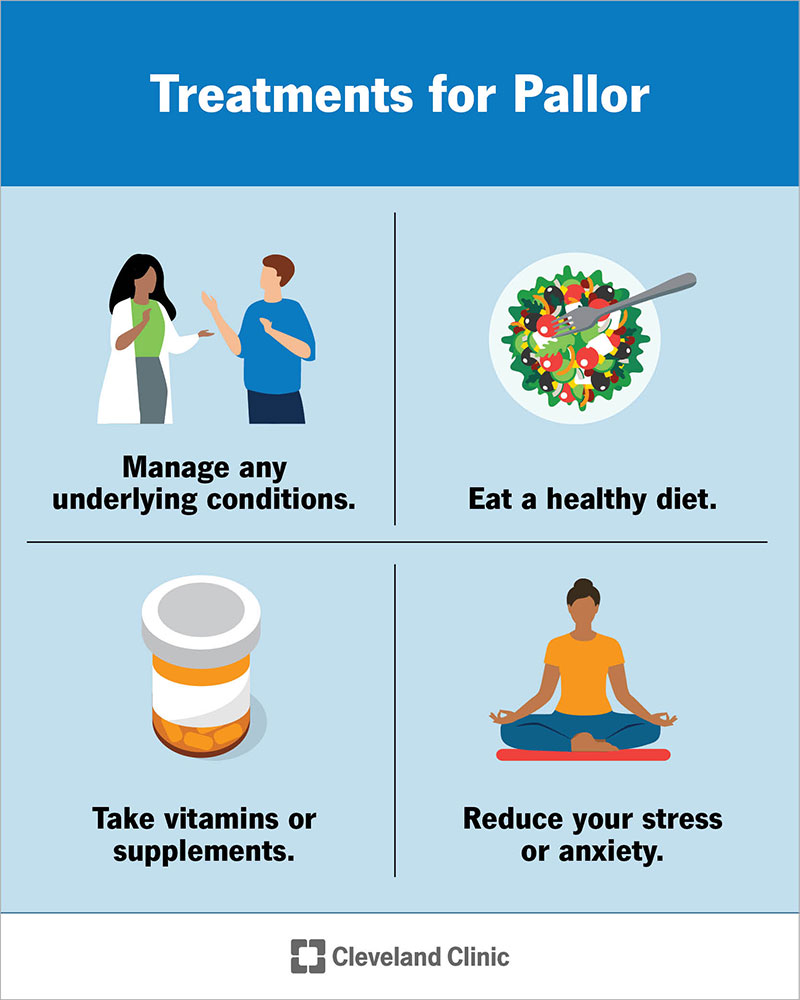Pallor is skin paleness. It occurs when your skin or mucous membranes, like the lining of your eyes, turn a lighter color than normal. There are several causes of pallor. They range from emotional distress to an underlying condition, like anemia. Pallor is usually temporary. It goes away once you treat or manage its cause.
Advertisement
Cleveland Clinic is a non-profit academic medical center. Advertising on our site helps support our mission. We do not endorse non-Cleveland Clinic products or services. Policy
Pallor, pronounced “pal-oar,” means paleness or a loss of color from your normal skin tone. Pallor affects your skin and mucous membranes. Your mucous membranes are the moist lining of the inside of your body, like the inside of your nose, your lungs and your mouth. Pallor is usually temporary, and your skin will go back to normal. However, you may have long-term paleness if an underlying, undiagnosed condition causes your symptoms. Treatment for any underlying condition resolves paleness.
Advertisement
Cleveland Clinic is a non-profit academic medical center. Advertising on our site helps support our mission. We do not endorse non-Cleveland Clinic products or services. Policy
No, pallor and albinism are different conditions. Albinism occurs when your body doesn’t produce pigment. Pigment is the color of your skin, hair and eyes. Pallor is the sudden loss of color to your skin, and it doesn’t affect your pigment. With treatment and lifestyle changes, your natural skin tone will return to normal after a pallor diagnosis.
Symptoms of pallor include:
If pallor occurs because of an underlying condition, you may experience the following symptoms in addition to skin paleness:
Pallor can affect the skin on your whole body or your mucous membranes, but it’s most notable on your:
Localized pallor is a term that refers to paleness on only one limb. For example, if you have localized pallor, you might only have paleness on your right arm after an injury. Localized pallor may be a sign of an underlying condition, so it’s important to visit a healthcare provider if you have this symptom.
Advertisement
A decrease in blood supply and oxygen in your skin causes pallor. There are many reasons why pallor occurs, ranging from:
Pallor can be a symptom of a condition including but not limited to the following:
Pallor can affect anyone, from children to adults. It’s a common condition to find in movies and television shows during dramatic and suspenseful moments. For example, a character feels fear or shock, turns pale and faints. While these scenarios in the media aren’t the most accurately depicted, they bring awareness to the symptoms of pallor to look out for in yourself, your family and friends.
A healthcare provider will diagnose pallor after taking a complete medical history and performing a physical exam. They may ask you questions about your symptoms, like:
Your provider might offer tests to confirm a diagnosis or determine what caused your symptoms. Tests could include:

Treatment for pallor varies based on what caused the paleness of your skin. Your healthcare provider will offer diagnostic tests to help them choose the best treatment for you and your symptoms. Treatment for pallor could include:
For rare but severe cases of pallor, you may need surgery or blood transfusions. These may be necessary if you’re recovering from a traumatic injury or have blockages in your arteries or internal bleeding.
Pallor is usually a temporary condition, so your symptoms could go away in a few minutes to hours or a few days, depending on what caused your symptoms. Paleness caused by emotional distress like fear or anxiety usually goes away quickly when you’re able to lower your heart rate to a normal level and relax. Conditions like anemia may take longer to treat and manage, so it could take several months before your skin returns to its usual tone.
Advertisement
Your outlook with pallor, or skin paleness, depends on what caused your symptoms and how soon you seek treatment. Usually, pallor clears up quickly after a diagnosis and treatment or management of the underlying condition.
Pallor can be a sign of a condition that needs immediate treatment, so don’t delay visiting a healthcare provider if your skin becomes unusually pale.
You can’t entirely prevent pallor, but you can reduce your risk of skin paleness by:
Visit your healthcare provider if:
Hearing the phrase, “You look pale,” during a dramatic television show or movie can lead to suspense or an adrenaline-pumping reaction to the characters on your screen. In reality, it can cause concern if it happens to you or someone you know. Pallor causes skin paleness and, potentially, symptoms of dizziness, a rapid heart rate or difficulty breathing. If your skin doesn’t return to normal or you have paleness along with symptoms that affect your ability to thrive, don’t delay and visit a healthcare provider.
Advertisement
Cleveland Clinic’s primary care providers offer lifelong medical care. From sinus infections and high blood pressure to preventive screening, we’re here for you.

Last reviewed on 09/29/2023.
Learn more about the Health Library and our editorial process.